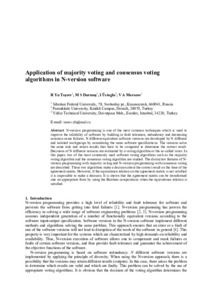Application of majority voting and consensus voting algorithms in N-version software
Скачать файл:
URI (для ссылок/цитирований):
http://iopscience.iop.org/article/10.1088/1742-6596/1015/4/042059/metahttps://elib.sfu-kras.ru/handle/2311/111516
Автор:
Царев, Р. Ю.
M, S Durmuş
I, Üstoglu
Морозов, В. А.
Коллективный автор:
Институт космических и информационных технологий
Кафедра информатики
Дата:
2018-05Журнал:
Journal of Physics: Conference SeriesКвартиль журнала в Scopus:
Q3Квартиль журнала в Web of Science:
без квартиляБиблиографическое описание:
Царев, Р. Ю. Application of majority voting and consensus voting algorithms in N-version software [Текст] / Р. Ю. Царев, S Durmuş M, Üstoglu I, В. А. Морозов // Journal of Physics: Conference Series. — 2018. — Т. 1015 (№ 4).Аннотация:
N-version programming is one of the most common techniques which is used to improve the reliability of software by building in fault tolerance, redundancy and decreasing common cause failures. N different equivalent software versions are developed by N different and isolated workgroups by considering the same software specifications. The versions solve the same task and return results that have to be compared to determine the correct result. Decisions of N different versions are evaluated by a voting algorithm or the so-called voter. In this paper, two of the most commonly used software voting algorithms such as the majority voting algorithm and the consensus voting algorithm are studied. The distinctive features of Nversion programming with majority voting and N-version programming with consensus voting are described. These two algorithms make a decision about the correct result on the base of the agreement matrix. However, if the equivalence relation on the agreement matrix is not satisfied it is impossible to make a decision. It is shown that the agreement matrix can be transformed into an appropriate form by using the Boolean compositions when the equivalence relation is satisfied.
Коллекции:
Метаданные:
Показать полную информациюСвязанные материалы
Показаны похожие ресурсы по названию, автору или тематике.
-
A new parallel version of a dichotomy based algorithm for indexing powder diffraction data
Ivan, Šimeček; Aleksandr, Zaloga; Jan, Trdlička (2020-06)One of the key parts of the crystal structure solution process from powder diffraction data is the determination of the lattice parameters from experimental data shortly called indexing. The successive dichotomy method is ... -
Classification of voting algorithms for N-version software
Царев, Р. Ю.; M, S Durmuş; I, Üstoglu; Морозов, В. А. (2018-05)A voting algorithm in N-version software is a crucial component that evaluates the execution of each of the N versions and determines the correct result. Obviously, the result of the voting algorithm determines the outcome ... -
Recursive algorithm for exhaustive search of possible multiversion software realizations with the choice of the optimal versions set
Царев, Р. Ю.; Грузенкин, Д. В.; Гришина, Г. В. (2018-04)N-version software is used all over the world as one of the approaches that can provide with the high level of reliability and software fault tolerance. The application of redundant module versions of software allows to ... -
Simulation environment for the choice of the decision making algorithm in multi-version real-time system
Ковалев, Игорь Владимирович; Сарамуд, Михаил Владимирович; Лосев, Василий Владимирович (2020-04)Context: Nowadays the most effective way to improve the reliability of software is an approach with the introduction of software redundancy - multi-version programming. The reliability of a multi-version system is determined ... -
Анализ параметризированных алгоритмов на основе эластичности функций сложности
Bykova, Valentina V.; Быкова, Валентина В. (Сибирский федеральный университет. Siberian Federal University., 2011-04)We give a brief overview of results and problems of parameterized algorithmics as the new direction of computational complexity theory. We offer a new indicator of computational complexity for parameterized algorithm ...

